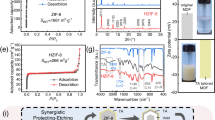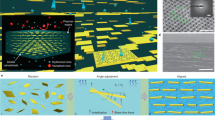Abstract
The implementation of membrane-based separations in the petrochemical industry has the potential to reduce energy consumption significantly relative to conventional separation processes1. Achieving this goal, however, requires the development of new membrane materials with greater selectivity, permeability and stability than available at present. Here, we report composite materials consisting of nanocrystals of metal–organic frameworks dispersed within a high-performance polyimide, which can exhibit enhanced selectivity for ethylene over ethane, greater ethylene permeability and improved membrane stability. Our results suggest that framework–polymer interactions reduce chain mobility of the polymer while simultaneously boosting membrane separation performance. The increased stability, or plasticization resistance, is expected to improve membrane utility under real process conditions for petrochemical separations and natural gas purification. Furthermore, this approach can be broadly applied to numerous polymers that encounter aggressive environments, potentially making gas separations possible that were previously inaccessible to membranes.
This is a preview of subscription content, access via your institution
Access options
Subscribe to this journal
Receive 12 print issues and online access
$259.00 per year
only $21.58 per issue
Buy this article
- Purchase on Springer Link
- Instant access to full article PDF
Prices may be subject to local taxes which are calculated during checkout




Similar content being viewed by others
References
Materials for Separation Technology: Energy and Emission Reduction Opportunities (US Department of Energy, 2005).
Eldridge, R. B. Olefin/paraffin separation technology: a review. Ind. Eng. Chem. Res. 32, 2208–2212 (1993).
Rungta, M., Zheng, C. & Koros, W. J. Membrane-based ethylene/ethane separation: the upper bound and beyond. AIChE J. 59, 3475–3489 (2013).
Baker, R. W. & Low, B. T. Gas separation membrane materials: a perspective. Macromolecules 47, 6999–7013 (2014).
Peng, Y. et al. Metal–organic framework nanosheets as building blocks for molecular sieving membranes. Science 346, 1356–1359 (2014).
Celebi, K. et al. Ultimate permeation across atomically thin porous graphene. Science 344, 289–292 (2014).
Li, H. et al. Ultrathin, molecular-sieving graphene oxide membranes for selective hydrogen separation. Science 342, 95–98 (2013).
Brown, A. J. et al. Interfacial processing of metal–organic framework hollow fiber membranes. Science 345, 72–75 (2014).
Park, H. B. et al. Polymers with cavities tuned for fast selective transport of small molecules and ions. Science 318, 254–258 (2007).
Wind, J. D., Staudt-Bickel, C., Paul, D. R. & Koros, W. J. The effects of crosslinking chemistry on CO2 plasticization of polyimide gas sepation membranes. Ind. Eng. Chem. Res. 41, 6139–6148 (2002).
Bloch, E. D. et al. Hydrocarbon separations in a metal–organic framework with open iron(II) coordination sites. Science 335, 1606–1610 (2012).
Qiu, S., Xue, M. & Zhu, G. Metal–organic framework membranes: from synthesis to separation application. Chem. Soc. Rev. 43, 6116–6140 (2014).
Zhang, C., Dai, Y., Johnson, J. R., Karvan, O. & Koros, W. J. High performance ZIF-8/6FDA-DAM mixed-matrix membranes for propylene/propane separations. J. Membr. Sci. 389, 34–42 (2012).
Rodenas, T. et al. Metal–organic framework nanosheets in polymer composite materials for gas separation. Nature Mater. 14, 48–55 (2015).
Bae, T.-H. & Long, J. R. CO2/N2 separations with mixed-matrix membranes containing Mg2(dobdc) nanocrystals. Energy Environ. Sci. 6, 3565–3569 (2013).
Liu, C., McCulloch, B., Wilson, S. T., Benin, A. I. & Schott, M. E. Metal organic framework-polymer mixed matrix membranes. US patent 7,637,983 B1 (2009).
Ranjan, R. & Tsapatsis, M. Microporous metal organic framework membrane on porous support using the seeded growth method. Chem. Mater. 21, 4920–4924 (2009).
Seoane, B. et al. Metal–organic framework based mixed matrix membranes: a solution for highly efficient CO2 capture? Chem. Soc. Rev. 44, 2421–2454 (2015).
Venna, S. R. et al. Fabrication of MMMs with improved gas separation properties using externally-functionalized MOF particles. J. Chem. Mater. A 3, 5014–5022 (2015).
Ploegmakers, J., Japip, S. & Nijmeijer, K. Mixed matrix membranes containing MOFs for ethylene/ethane separation Part A: Membrane preparation and characterization. J. Membr. Sci. 428, 445–453 (2013).
Bux, H., Chmelik, C., Krishna, R. & Caro, J. Ethylene/ethane separation by the MOF membrane ZIF-8: molecular correlation of permeation, adsorption, diffusion. J. Membr. Sci. 369, 284–289 (2011).
Herm, Z. R., Bloch, E. D. & Long, J. R. Hydrocarbon separations in metal–organic frameworks. Chem. Mater. 26, 323–338 (2014).
Bae, Y.-S. et al. High propene/propane selectivity in isostructural metal–organic frameworks with high densities of open metal sites. Angew. Chem. Int. Ed. 51, 1857–1860 (2012).
Bloch, E. D. et al. Selective binding of O2 over N2 in a redox-active metal-organic framework with open iron(II) coordination sites. J. Am. Chem. Soc. 133, 14814–14822 (2011).
Rosi, N. L. Rod packings and metal–organic frameworks constructed from rod-shaped secondary building units. J. Am. Chem. Soc. 127, 1504–1518 (2005).
Geier, S. J. et al. Selective adsorption of ethylene over ethane and propylene over propane in the metal-organic frameworks M2(dobdc) (M = Mg, Mn, Fe, Co, Ni, Zn). Chem. Sci. 4, 2054–2061 (2013).
Caskey, S. R., Wong-Foy, A. G. & Matzger, A. J. Dramatic tunic of carbon dioxide uptake via metal substitution in a coordination polymer with cylindrical pores. J. Am. Chem. Soc. 130, 10870–10871 (2008).
Tanaka, K., Taguchi, A., Hao, J., Kita, H. & Okamoto, K. Permeation and separation properties of polyimide membranes to olefins and paraffins. J. Membr. Sci. 121, 187–207 (1996).
Bos, A., Punt, I. G. M., Wessling, M. & Strathmann, H. CO2-induced plasticization in glassy polymers. J. Membr. Sci. 31, 67–78 (1999).
Frisch, H. L. The time lag in diffusion. J. Phys. Chem. 61, 93–95 (1957).
Dymond, J. H., Marsh, K. N., Wilhoit, R. C. & Wong, K. C. (eds) The Virial Coefficients of Pure Gases and Mixtures Vol. IV (Oxford Univ. Press, 2001).
Lemmon, E. W., Huber, M. L. & McLinden, M. O. NIST Standard Reference Database 23: NIST Reference Fluid Thermodynamic and Transport Properties (REFPROP) Version 8.0 (NIST, 2007).
Queen, W. L. et al. Comprehensive study of carbon dioxide adsorption in metal-organic frameworks M2(dobdc) (M = Mg, Mn, Fe, Co, Ni, Cu, Zn). Chem. Sci. 5, 4569–4581 (2015).
Paul, D. R. & Koros, W. J. Effect of partially immobilizing sorption on permeability and the diffusion time lag. J. Polym. Sci. 14, 675–685 (1976).
Ohya, H., Kudryavtsev, V. V. & Semenova, S. I. Polyimide Membranes: Applications, Fabrications, and Properties (Gordon and Breach, 1996).
Ghosh, M. K. & Mital, K. L. Polyimides: Fundamentals and Applications (Marcel, 1996).
Grubb, T. L. et al. Highly soluble polyimides from sterically hindered diamines. Polymer 40, 4279–4288 (1999).
Matsuura, T., Hasuda, Y., Nishi, S. & Yamada, N. Polyimide derived from 2,2′-bis (triflouromethyl)-4,4′-diaminobiphenyl. S. synthesis and characterization of polyimides prepared with 2,2′-bis (3,4-dicarboxyphenyl)hexafluoropropane dianhydride or pyromellitic dianhydride. Macromolecules 24, 5001–5005 (1991).
Acknowledgements
This research was supported through the Center for Gas Separations Relevant to Clean Energy Technologies, an Energy Frontier Research Center funded by the US Department of Energy, Office of Science, Office of Basic Energy Sciences under Award DE-SC0001015. We thank J. Mason for helpful discussions. We also thank the NSF for providing graduate fellowship support for J.E.B.
Author information
Authors and Affiliations
Contributions
J.E.B. and J.R.L. formulated the project. J.E.B. synthesized nanocrystals and fabricated membranes. Z.P.S. contributed valuable theoretical insights, synthesized 6FDA-DAM, and assisted in construction of permeation equipment. J.E.B. collected all powder diffraction, dynamic light scattering, scanning electron microscopy, Soxhlet extractions, gas adsorption, and gas permeation data. T.L. performed transmission electron microscopy imaging. J.E.B. and J.R.L. wrote the paper, and all authors contributed to revising the paper.
Corresponding author
Ethics declarations
Competing interests
The authors declare no competing financial interests.
Supplementary information
Supplementary Information
Supplementary Information (PDF 24310 kb)
Rights and permissions
About this article
Cite this article
Bachman, J., Smith, Z., Li, T. et al. Enhanced ethylene separation and plasticization resistance in polymer membranes incorporating metal–organic framework nanocrystals. Nature Mater 15, 845–849 (2016). https://doi.org/10.1038/nmat4621
Received:
Accepted:
Published:
Issue Date:
DOI: https://doi.org/10.1038/nmat4621
This article is cited by
-
Remarkable enhancement of gas selectivity on organosilica hybrid membranes using urea-modulated metal-organic framework nanoparticles
Frontiers of Chemical Science and Engineering (2024)
-
Precise molecular sieving of ethylene from ethane using triptycene-derived submicroporous carbon membranes
Nature Materials (2023)
-
PolyMOF nanoparticles constructed from intrinsically microporous polymer ligand towards scalable composite membranes for CO2 separation
Nature Communications (2023)
-
Asymmetric pore windows in MOF membranes for natural gas valorization
Nature (2022)
-
Unraveling the molecular mechanism of MIL-53(Al) crystallization
Nature Communications (2022)



